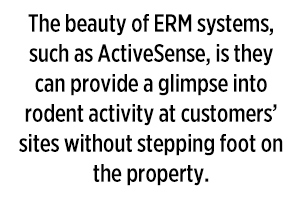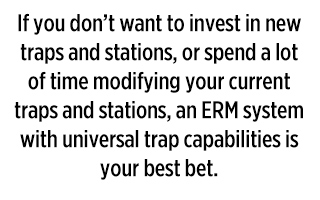
The COVID-19 pandemic has made two things clear. First, it showed us just how reliant rodents are on humans as a food source. Second, it further demonstrated how important pest management professionals (PMPs) are at addressing and eliminating rodent infestations in our communities. When daily habits began to change in March, PMPs reported seeing strange activity in rodents: signs of muricide (rats killing mice), cannibalism and more. These signs showed that rodents had both the tenacity and intellect to survive during a pandemic.
Fortunately, PMPs who have invested in electronic remote monitoring (ERM) systems, such as ActiveSense®, have been able to study, track and respond to this behavior in real time, simultaneously meeting customer needs and bolstering their bottom lines by promptly addressing infestations.
So, how is ERM helping to solve evolving rodent behavior during the COVID-19 pandemic?
Tracking rodent behavior during a pandemic

With social distancing guidelines in place, on top of limited or restricted access to businesses, rodent control inspections and service visits are evolving. For example, PMPs who have invested in an ERM system have been able to continue to monitor rodent activity around the clock. Through real-time alerts of detected trap activity, ERM is helping them come prepared when on-site while also honoring social distancing requirements.
The beauty of ERM systems, such as ActiveSense, is they can provide a glimpse into rodent activity at customers’ sites without stepping foot on the property.

Photo: Corteva Agriscience™
When an activity alert is received, the PMP knows exactly which trap to service, allowing him or her to limit contact and adhere to site restrictions. Of course, if there’s no activity recorded, the PMP knows service is not immediately required and thus can continue to monitor the situation without a site visit, providing peace of mind to both the PMP and the customer.
In addition to remote monitoring, many ERM solutions also include a mobile app or web portal that allows PMPs to check the status of traps; monitor and pinpoint any rodent activity; and gather trend data to help identify areas within a client’s site with the highest rodent pressures.
Photo: Pierre Aden/iStock / Getty Images Plus/Getty Images
The benefits of ERM
As the COVID-19 pandemic continues to impact nearly every aspect of modern life, ERM technology is almost certain to grow. That’s because its business value extends far beyond its ability to aid in social distancing. With more ERM options available to PMPs now than ever before, it can make it difficult to determine which is the best fit for your business needs. To help you narrow down your options, here are a few considerations:
-
Trap capabilities:
 Some ERM systems require modifications to a trap for the sensor to work properly, while others only work with the manufacturer’s devices. If you don’t want to invest in new traps and stations, or spend a lot of time modifying your current traps and stations, an ERM system with universal trap capabilities is your best bet. Some ERM systems, like ActiveSense, can even be used on wildlife traps for added value and usability.
Some ERM systems require modifications to a trap for the sensor to work properly, while others only work with the manufacturer’s devices. If you don’t want to invest in new traps and stations, or spend a lot of time modifying your current traps and stations, an ERM system with universal trap capabilities is your best bet. Some ERM systems, like ActiveSense, can even be used on wildlife traps for added value and usability. -
Service verification:
Ever had customers claim their site wasn’t serviced because they didn’t see the technician on-site? ERM systems can provide a digital record of service that can aid in resolving these specific customer concerns. However, some systems only require the technician to be in the area to record service, which means there’s no guarantee that the trap was actually checked.
Some ERM systems, like ActiveSense, require the technician to open the trap and hold their phone near the sensor to record the service of a trap, which is something that can’t be faked. This is especially important for audit-compliant sites, such as food processing and manufacturing.
-
True remote monitoring:
Some systems only provide digital monitoring, which means trap activity is only updated once the technician is on-site and within a certain range of the sensors. A true remote monitoring system like ActiveSense helps you know what to expect before you arrive on-site so you can come prepared.
For instance, if you receive a real-time alert late at night when the client site is closed, you know you’re dealing with a rodent, and you’ll come ready for a cleanout. If you receive a real-time alert during the middle of the day, you know it was likely triggered by an employee or, worse, a forklift, and you can come prepared with a replacement trap and sensor just in case.

Photo: Corteva Agriscience™
The benefits of ERM technology, such as ActiveSense, go far beyond a national pandemic. Because the technology gives you a window into rodent activity 24/7, it can be useful in identifying the root cause of the rodent problem — such as revealing a previously unknown entry point or rodent nest location — that can assist in expediting the resolution. It can even help with employee retention by reducing the wear-and-tear of a technician’s job by reducing the number of traps that need to be checked. By reserving technicians’ energy for more value-added preventative services, like strategic inspections, your customers are left better protected from future rodent issues.
This page was produced by North Coast Media’s content marketing staff in collaboration with ActiveSense. NCM Content Marketing connects marketers to audiences and delivers industry trends, business tips and product information. The Pest Management Professional editorial staff did not create this content.
Header photo: Corteva Agriscience™; Graphics: PMP Staff